Some part of me wanted to hike all 28 miles of the Ohlone Wilderness Trail in the worst way, which I can safely say includes:
- Hiking in rain and pea-soup fog for the five miles of the trail I’d never seen, so I’ll have to return on a sunny day to see what it actually looks like.
- Camping out in the rain (first law of hydrodamics: water gets into everything).
- Twisting and turn all night because my feet refuse to warm up, which keeps the rest of me from staying asleep for more than 60 minutes at a stretch.
- Next morning, all I have to do is walk 18 miles, with a convenient hike over Mission Peak in the last eight miles just to make things interesting.
Not that I’m complaining.
Idea for this outing came from Steve Sergeant, a Sierra Club outing leader who was the instructor in a class on lightweight backpacking I took last year. Steve took a bunch of us deep into the innards of Henry Coe State Park to demonstrate his techniques for shaving pounds off one’s pack weight. It was an excellent outing, primarily because the weather was perfect and the scenery was wonderful.
This year the weather had other plans.
Three of us started out at the Lake Del Valle end of the Ohlone Trail hiking under cloudy skies. I was carrying about 25 pounds; Frank, the fastest hiker of the bunch, was carrying 27; and Steve, mostly to prove a point, had everything he needed crammed into a 9-pound kit, lighter than most people’s day pack.
That’s Steve in the white poncho. Note that this ultra-thin bit of nylon that isn’t big enough to keep his calves dry also is his tent. His stakes are little shards of aluminum similar to fondue skewers and his guylines are really thick-gauge sewing thread. His whole shelter kit weighs in at well under a pound; his pack weighs less than half a pound — the straps have no padding, but have sleeves to insert a pair of gloves to do that little task. Clever, eh?
All this ingenuity really accomplishes is relocating one’s discomfort. If you can stand to sleep out in the rain under a poncho with your nose six inches from the elements, and dash in and out of camp as fast as humanly possible because all your insulation is in your sleeping bag and hanging around at a campsite freezes your fanny off, then ultra-lighting may be for you.
Steve can handle this because he’s been doing outdoors stuff for 30 years and he’s done all the suffer-on-the-trail, live-it-up-in-camp stuff. Actually, Steve still does these outings too, but our recent weekend was a “fast and light” fling, which meant we were all on a diet, pack-weightwise.
So, back to the trail. The rain wasn’t terrible, but it was pervasive. We got caught on top of a ridge in a bit of a squall — I’m sure I felt a bit of sleet up there — but we were able to hike out of it.
Here’s a little pond along along the way. The blurriness is from moisture on the camera lens. Hard to keep it dry under these conditions.
A combination of fog and lens moisture create an interesting image. This is not far from the Maggie’s Half Acre campsite.
Steve and Frank at Campsite 3. We ended up with three shelters arrayed over that little yellowed patch near the tree. I have a floorless tent that weighs about a pound an a half and is held up by hiking poles. I got it set up as fast I could to get in out of the wind and rain. Amazing what a little shelter will do for your state of mind — and state of bodily warmth.
Next morning it was back to the California skies we know and love.
When I got up, Steve was still sleeping under his tiny A-framed tarp, which was pitched about two and a half feet high, with six inches of open space on either side. I asked him if that was enough shelter. “Just barely,” he said. He’d slept in a narrow cocoon that left almost zero space for twisting and turning, but he stayed warm and dry despite getting splashed in the face a few times. He also said these were the worst conditions he’d camped out in with this poncho-as-tarp setup.
Mind you the weather was cool, wet and rainy, but not terribly severe; going this light can get you in deep doo-doo if major storms — sleet, snow, heavy rains, strong winds — crop up.
We had to pack up and hit the trail ASAP because Steve didn’t bring a hang-round-in-camp coat; we did breakfast a couple miles down the trail when we’d all had a chance to warm up a bit. The scenery markedly improved after the weather front went through.
A fine tree along the trail out of the campground.
Rose Peak, highest point on the trail, just before the sun tops the summit.
Amazing views at this time of morning.
Nice tree-and-reflection scene.
For once I was up here when the sunlight hit these rocks at just the right angle to highlight their coloration. Mission Peak is the little hump in the center of the break in the rocks.
The trail passes through the always-scenic Sunol Wilderness. This on the McCorkle Trail a few miles from the park headquarters.
From here it was a hike over familiar ground — lord knows I’ve posted enough Mission Peak and Sunol Wilderness pix here on previous hikes. The climb up to Mission Peak was a bit of drag, mostly because my legs and back hadn’t gotten back into the habit of carrying extra weight for these kinds of distances.
So those are the highlights. I also have good news for those who love to gaze at wildflowers: they should be out in quantity in the next few weeks.


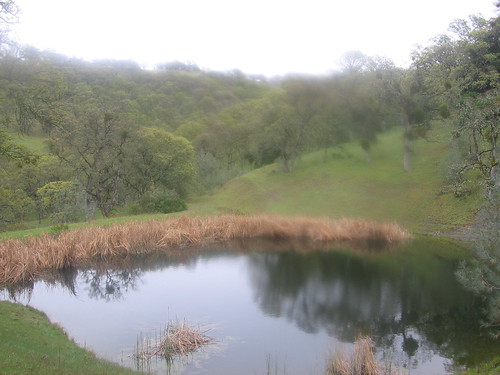
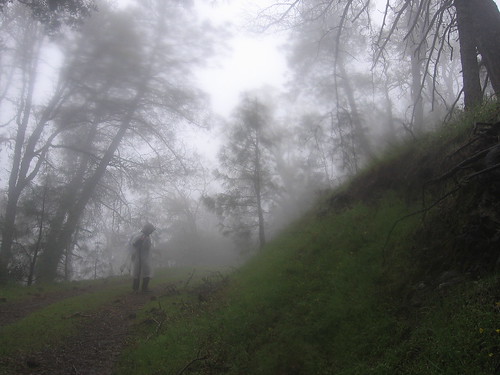
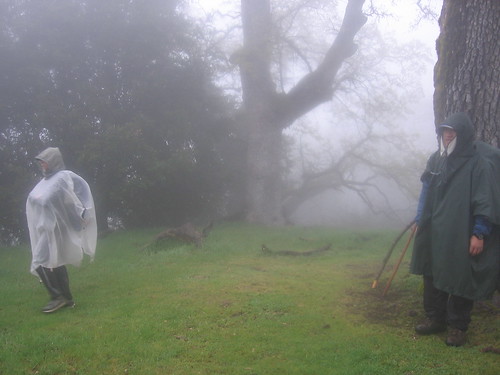
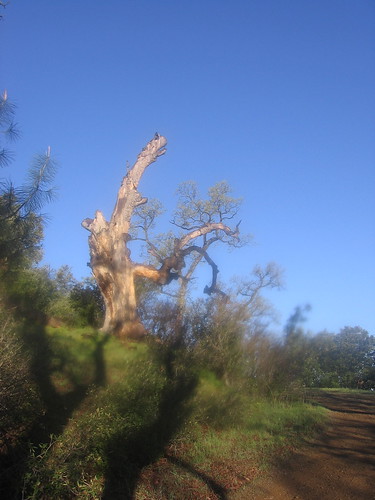

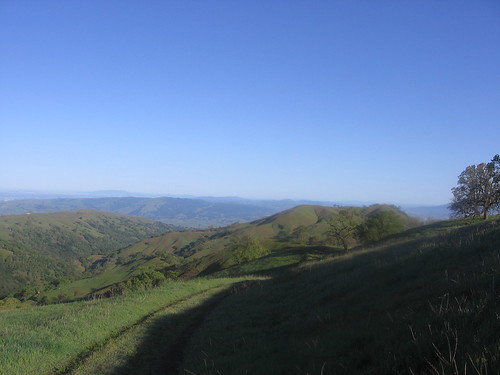
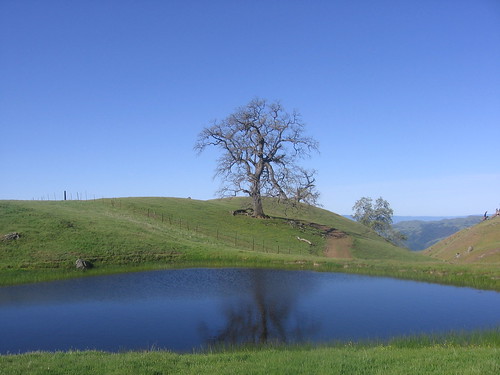
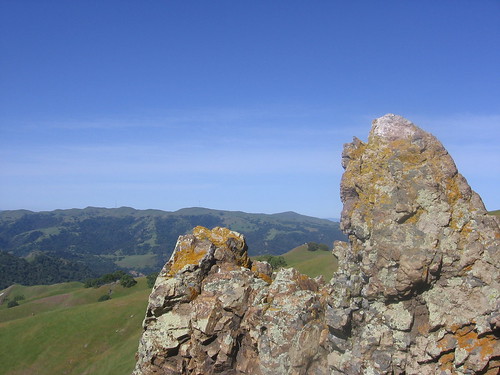
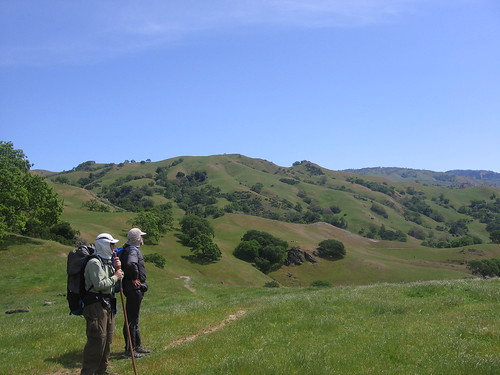
I was on Rocky Ridge at Las Trampas about the time you guys were on Mission Peak. I squinted real hard, but couldn’t make a positive ID.
Congratulations on completing the trip. I really wanted to join you, but I’m in the middle of a month’s worth of Saturday “professional development” classes.
Took lots of intestinal fortitude to grit this one out, guys!
Tom, you make it sound like you didn’t have a good time.
In hindsight I would have started the hike about two hours later. But when park rules force us to camp in a particular locations, we need to build-in some extra time in case there are unexpected delays getting there.
So I’m not sure about you, but I had a blast. Remember my definition of adventure: You know it’s an adventure when it’s at least as much fun to tell about it as it was to do it.
Hey, I didn’t even mention that I discovered I had busted my $200 prescription sunglasses before taking the first step. That sorta set the stage for me.
To me, fun is not a requirement for something to be worthwhile. Nice to have during an attempt at “recreation,” I suppose, but not a prerequisite.
I knew going in that camping in the rain was not going to be pleasant, and I knew hiking 28 miles on untrained legs was going to suck. I went anyway because I had to get the suckage out of the way, to give me a chance to have more fun the next time.
So, yeah, maybe not a “good time,” but not a waste of time either.
Sometimes you gots to do what you gots to do and this adventure sounds like one of those things you just gots to do. And for me sitting in the comfy of my home, your report makes some of the best reading yet as I think about entering the world of backpacking. 🙂 By the way, nice selection of pictures too!
Hey, I think we met you up there at Boyd Camp on the way in! Some in our party camped at Maggie’s that night, some met you at Boyd Camp and went back to the cars after a refreshing and very stormy night. I remember those bare legs in that cold and sleety morning. Here’s to plenty more adventures! Maureen
I rescently hiked the Del Valle to Sunol portion in one day with a pack around 15lbs with water and food. It was a tough but enjoyable hike; the area is beautiful and your photos capture it well. Thanks for the great read!
I would like to do this hike the end of May. I am not a hiker… Is this a hike my friends and I could do in 48 hours?
Natalie: two issues:
1) it’s a very strenuous hike — if you jog several miles a day or train for triathlons, you’re probably up for it. Carrying a pack with 25-30 pounds of overnight gear & food will make it even more difficult. Also, it’s 14 miles a day to do it in 48 hours (on this hike, we did 10 miles the first day and 18 miles the second. With a pack it’s a major haul).
2) If you’re planning to go on a weekend, Reservations for all the campsites along the way are surely all booked up . IF you took two days out of the middle of the week you might be OK.